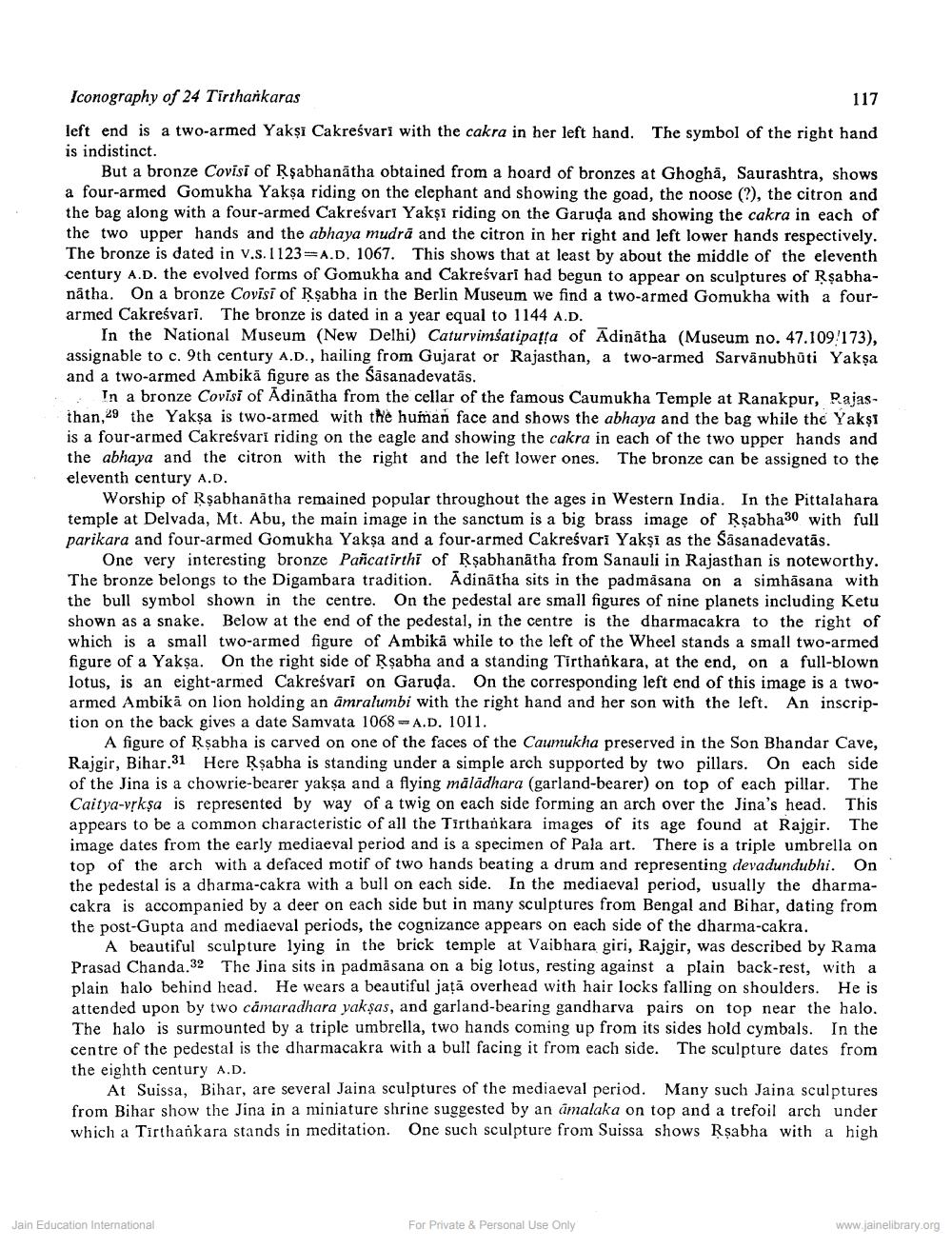________________
Iconography of 24 Tirtharkaras
117
left end is a two-armed Yakşi Cakreśvari with the cakra in her left hand. The symbol of the right hand is indistinct.
But a bronze Covisi of Rşabhanātha obtained from a hoard of bronzes at Ghogha, Saurashtra, shows a four-armed Gomukha Yakşa riding on the elephant and showing the goad, the noose (?), the citron and the bag along with a four-armed Cakreśvari Yakşi riding on the Garuda and showing the cakra in each of the two upper hands and the abhaya mudrā and the citron in her right and left lower hands respectively. The bronze is dated in v.s. 1123=A.D. 1067. This shows that at least by about the middle of the eleventh century A.D. the evolved forms of Gomukha and Cakreśvari had begun to appear on sculptures of Rşabhanātha. On a bronze Covīsi of Rşabha in the Berlin Museum we find a two-armed Gomukha with a fourarmed Cakreśvari. The bronze is dated in a year equal to 1144 A.D.
In the National Museum (New Delhi) Caturvimsatipatta of Ādinātha (Museum no. 47.109/173), assignable to c. 9th century A.D., hailing from Gujarat or Rajasthan, a two-armed Sarvänubhūti Yakşa and a two-armed Ambikā figure as the Sāsanadevatās.
In a bronze Covisi of Ādinātha from the cellar of the famous Caumukha Temple at Ranakpur, Rajasthan 29 the Yaksa is two-armed with the human face and shows the abhaya and the bag while the Yakşi is a four-armed Cakreśvari riding on the eagle and showing the cakra in each of the two upper hands and the abhaya and the citron with the right and the left lower ones. The bronze can be assigned to the eleventh century A.D.
Worship of Rsabhanātha remained popular throughout the ages in Western India. In the Pittalahara temple at Delvada, Mt. Abu, the main image in the sanctum is a big brass image of Rşabha 30 with full parikara and four-armed Gomukha Yaksa and a four-armed Cakreśvari Yakşi as the Sāsanadevatās.
One very interesting bronze Pañcatirthi of Rşabhanātha from Sanauli in Rajasthan is noteworthy. The bronze belongs to the Digambara tradition. Adinātha sits in the padmasana on a simhasana with the bull symbol shown in the centre. On the pedestal are small figures of nine planets including Ketu shown as a snake. Below at the end of the pedestal, in the centre is the dharmacakra to the right of which is a small two-armed figure of Ambikä while to the left of the Wheel stands a small two-armed figure of a Yaksa. On the right side of Rşabha and a standing Tirthankara, at the end, on a full-blown lotus, is an eight-armed Cakreśvari on Garuda. On the corresponding left end of this image is a twoarmed Ambikā on lion holding an amralumbi with the right hand and her son with the left. An inscription on the back gives a date Samvata 1068 - A.D. 1011.
A figure of Rsabha is carved on one of the faces of the Caumukha preserved in the Son Bhandar Cave, Rajgir, Bihar.31 Here Rşabha is standing under a simple arch supported by two pillars. On each side of the Jina is a chowrie-bearer yakșa and a flying malādhara (garland-bearer) on top of each pillar. The Caitya-vrkça is represented by way of a twig on each side forming an arch over the Jina's head. This appears to be a common characteristic of all the Tirtharkara images of its age found at Rajgir. The image dates from the early mediaeval period and is a specimen of Pala art. There is a triple umbrella on top of the arch with a defaced motif of two hands beating a drum and representing devadundubhi. On the pedestal is a dharma-cakra with a bull on each side. In the mediaeval period, usually the dharmacakra is accompanied by a deer on each side but in many sculptures from Bengal and Bihar, dating from the post-Gupta and mediaeval periods, the cognizance appears on each side of the dharma-cakra.
A beautiful sculpture lying in the brick temple at Vaibhara giri, Rajgir, was described by Rama Prasad Chanda.32 The Jina sits in padmāsana on a big lotus, resting against a plain back-rest, with a plain halo behind head. He wears a beautiful jață overhead with hair locks falling on shoulders. He is attended upon by two cámaradhara yakşas, and garland-bearing gandharva pairs on top near the halo. The halo is surmounted by a triple umbrella, two hands coming up from its sides hold cymbals. In the centre of the pedestal is the dharmacakra with a bull facing it from each side. The sculpture dates from the eighth century A.D.
At Suissa, Bihar, are several Jaina sculptures of the mediaeval period. Many such Jaina sculptures from Bihar show the Jina in a miniature shrine suggested by an amalaka on top and a trefoil arch under which a Tirtharkara stands in meditation. One such sculpture from Suissa shows Rşabha with a high
Jain Education International
For Private & Personal Use Only
www.jainelibrary.org




